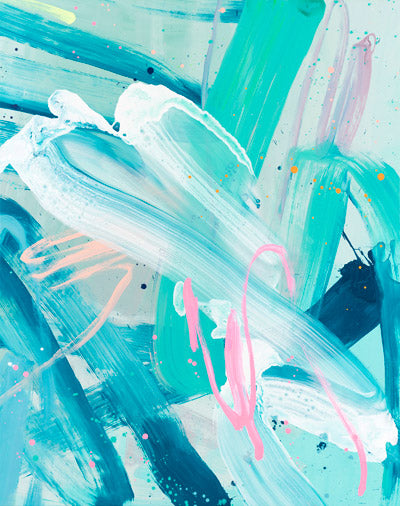Rowena Martinich’s newest offering to the world of public art, her ‘translucent painted tunnel’ entitled Viachroma is a dramatic explosion of colour and light.[1]
For Martinich, painting is ‘an elemental and private practice’.[2] It is a practice marked by ‘raw emotion’.[3] We could deduce from Viachroma that her emotional life is thus imbued with dynamic explosions of intense feeling, a frenzy of elation, rapture, and at times, fury. But what is Martinich‘s ultimate goal through her work? Is it to convey a gamut of personal feeling or is it more than that? Clearly, it is not only impulsive energy that drives her work.
Today, the role of the public artist is to inject our cities, our urban and public spaces, with imaginative and creative possibilities. Public authorities realise that creativity has its place in enlivening spaces and encouraging community members to imagine – to be inspired, to feel reawakened. Indeed, through initiatives such as these, there is now recognition that successful urban centres offer more than just functionality. In recent projects supported by the Department of Infrastructure, Transport, Regional Development and Local Government, bus stops and railway stations are now purposefully used as blank canvases for artists to transform into sites of expression.
Drawn from the gestural and action painting of 1940s and 1950s Abstract Expressionism, Martinich’s approach to abstraction is fuelled with an added dimension. For it is not in the painted marks that her paintings are ‘ground breaking’ but in the sites that she seeks out to present this style of work. This preoccupation with bringing the world of abstraction to the experience of the general public posits Martinich’s practice within a field of enquiry that is seldom visited. In bringing the world of abstraction to the public domain, Martinich overcomes the shackles of ‘high art’ that even today may buffer its enjoyment by the general public. Historically, Abstract Expressionism issued the painter as a supreme being – a bearer of pure creative genius. Martinich has flipped this paradigm, activating the viewer, rather than the artist, with sole primacy. And in defying the traditional art-object as intrinsically valuable, the work is temporary and will eventually be discarded: Viachroma will exist only fleetingly.
In Viachroma, we find the contrast of the fluidity of paint within a rigid architectural environment: the Dandenong Station overpass. The site exists as an in-between-space, or a ‘non-place’, a space of transit rather than contemplation.[4] As commuters busily walk through this site, they will be exposed to a new sensation, transitory as it may be in their haste to get from A to B, this experience will nonetheless alter a period of time which would ordinarily be an empty interval, a ‘non-experience’, and shift it into a pleasant interruption of expressive colour and movement.
Martinich effectively unleashes her creative energy onto a most unassuming audience. She invites commuters to lift their heads, open their eyes – to experience the everyday, but differently. The work activates the interior space of the walkway but also projects like a giant canvas onto the external environment so that pedestrians, car passengers and shopkeepers will all see a new vision in the sky. The physical properties of paint render it an enveloping substance. Viachroma emphasises this by physically enveloping the viewer. The viewer is held three dimensionally within a painting that seeks to break up the homogeneity of urban space.
To traverse this walkway, one becomes cognisant of the quality of light, as at any given point in the day the artwork will be illuminated differently; the morning sun, the late afternoon glare, or the streetlights at night will all affect the work differently. The iridescent colours will be enhanced or softened depending on the time of day.
Ultimately Martinich’s work is based around this one key component: colour. Martinich is consumed by the ability of colour to create the illusion of depth and its ability to resonate on an emotional level. She is excited by the urban hum of the city, the constructed environment, the bright neon lights, the gridlock and she embraces the brightness and the colour of the inner city. Her sites of exploration are informed by rigid architectural constraints and yet she chooses to express herself within such spaces with a sense of openness and exposure.
The traces of her humanness, the physical energy embedded in each bold stroke of paint connects Martinich corporeally to the viewer. Martinich’s spontaneous, free expression takes us into fantastical realms, where the unsuspecting commuter might escape the everyday. Hers is an oasis from the concrete monotony of urban-living.
Viachroma invites pure wonder at, and immersion in, the visual field.
Claire Anna Watson
September 2009
[1] As the artist herself describes it in her Artist Statement (August 2009).
[2] Common Gesture, Masters Thesis, p.15
[3] op cit., p.126
[4] The term non-place was coined by Marc Auge in: Non Places – Introduction to an Anthropology of Supermodernity, London: Verso, 1995


Follow Us On Social